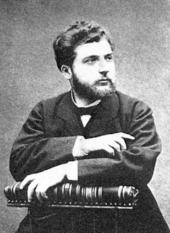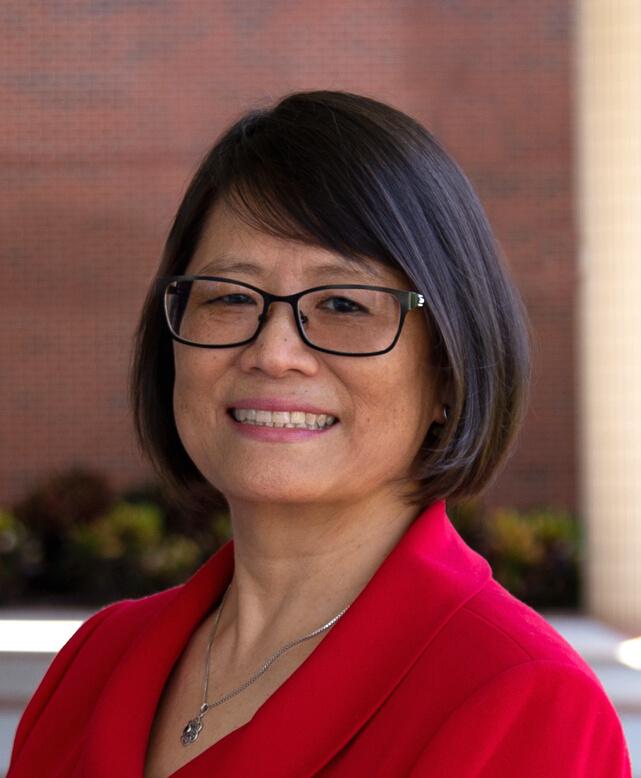Program notes
Georges Bizet: Aragonaise, from Carmen (arr. Richard Meyer)
Best known for his operas in a career cut short by his early death at the age of 36, French Romantic-era composer Georges Bizet achieved early musical success as a child and young adult at the Paris Conservatoire, and won the Prix de Rome, but after that he struggled to win critical acclaim. His first operas and other compositions were not successful.

His final work, Carmen, initially was considered a scandal, but after his death became one of the most popular and frequently performed works in the entire opera repertoire. He did not live long enough to know that he would be remembered as a brilliant master. Set in Spain, "Carmen" is a violent, colorful tale of love and jealousy between an amoral gypsy woman and a weak-willed soldier.

The "Aragonaise" (literally a person or thing from Aragon, a region in Spain) is the orchestra's interlude that introduces the opera's 4th act. Percussion, exciting rhythms, and soaring melodies make this a memorable tune. Bizet 's realistic approach to storytelling influenced the verismo school of opera at the end of the 19th century.
About the arranger: Richard Meyer (b. 1957) received his B.A. degree from California State University, Los Angeles. An active music educator and clinician, Mr. Meyer taught middle school instrumental music, public school orchestra, and conducted the Pasadena Youth Symphony Orchestra for over 16 years. Mr. Meyer has had many original compositions and arrangements published for band and orchestra.
Leroy Anderson: The Syncopated Clock


Two differently pitched woodblocks mimic the sound of a ticking clock throughout this lighthearted piece. By establishing a perfectly regular "tick-tock" at the opening, it draws attention to brief moments of syncopation, or placement of rhythmic stresses where they wouldn't normally occur, creating a whimsical and comic effect that reflects the composer's sense of humor American composer Leroy Anderson was born in Cambridge, Massachusetts to first-generation Swedish immigrant parents. Leroy was given piano lessons by his mother, then entered the New England Conservatory at age 11 and later earned a BA and MA in music from Harvard University.
Unsure that a career in music would be posisble, Leroy considered becoming a language teacher, and began working on a PhD in German and Scandinavian languages. This would later come in handy while he served in the U.S. Army. He soon found success when conductor Arthur Fiedler of the Boston Pops noticed his compositions, and introduced all of America to hits like Sleigh Ride and Blue Tango. The Syncopated Clock was composed in Arlington, Virginia, while Anderson was serving in the military during World War 2. Its 1950 debut recording, with Anderson himself conducting, hit No. 12 on the Billboard chart. The piece was also used as a theme song on a 1950s TV station late night movie show. When asked about the piece, Anderson said he thought of the title first and then worked the music so that it reflected the rhythm of a syncopated clock.
Georges Bizet (1838-1875)Richard Rodgers: Carousel Waltz, from Carousel (arr. Calvin Custer)

Richard Rodgers was an American composer who worked primarily in musical theater. His writing partnerships with lyricist Lorenz Hart and later with Oscar Hammerstein II resulted in 43 Broadway musicals. Rodgers was one of the most well-known American composers of the 20th century. As one critic put it, "Probably not a day goes by without a show of his being performed somewhere in the world." Instead of opening with a traditional overture, the musical (and movie) "Carousel" begins with a musical waltz suite. Originally choreographed by famous ballerina Agnes de Mille, the wordless ballet sets the scene for Carousel with characters interacting at the bustling fair, all set to Rodgers’ music, now known as "Carousel Waltz." From the opening section where the carousel is "warming up" with dissonant chords, to its sweeping waltz tune, you can imagine a carnival ride from start to finish.
 Richard Rodgers (1843-1907)
Richard Rodgers (1843-1907)
Calvin Custer (1939-1998) attended Carnegie Mellon University and Syracuse University. His composition teachers included Nikolai Lopatnikoff, Ernst Bacon, and Earl George. He also studied conducting with Karl Kritz, first music director of the Syracuse Symphony. Custer was associated with the Syracuse Symphony Orchestra during the majority of his musical career serving in the keyboard, horn and string bass sections; holding various conducting positions; and serving as staff arranger. He helped to implement the orchestra's chamber music program which continues to perform in local schools and libraries to this day. Calvin was a member of the both the rock and percussion ensembles in which he played numerous instruments including keyboard and guitar. Custer was prolific in his creations of arrangements for orchestra, many of which were performed by orchestras across the country including the Boston Pops Orchestra
Pyotr Tchaikovsky: Marche Slav (arr. Chris Bernotas)
Pyotr Tchaikovsky ((1840-1893), one of the most famous Russian composers of the Romantic era, was commissioned to write this piece for a benefit concert It was to raise money for Serb soldiers wounded while fighting, with help from Russian volunteers, against the Ottoman Empire The title (March Slav) declared it was for all Slavs rather than simply for Russians The piece includes a number of distinct moods; bright, festive passages contrast with ominous ones. At several moments, different sections of the orchestra carry their own melodies at the same time, creating a layered effect. As the march progresses toward its triumphant conclusion, the intensity of the music builds. Tchaikovsky's emotional use of national and folk tunes and his brilliant orchestration ensured that the piece enjoyed immediate success.


Tchaikovsky died at age 53, He was the first Russian composer whose music would make a lasting impression internationally He wrote some of the most popular concert and theatrical music in the current classical repertoire, including the ballets Swan Lake and The Nutcracker, the 1812 Overture, his First Piano Concerto, Violin Concerto, the Romeo and Juliet OvertureFantasy, several symphonies, and the opera Eugene Onegin.
About the arranger: composer, conductor, clinician, and educator Chris M. Bernotas (b.1969) earned a Bachelor of Music degree from William Paterson University and a Masters in the Art of Teaching from Marygrove College. As Director of Instrumental School Methods and Repertoire for Alfred Music, he draws upon his 28-year experience as an instrumental music teacher in New Jersey, and brings an energetic and enthusiastic approach to the world of music education. Mr. Bernotas is an active composer and arranger of concert band, string orchestra, and marching band music. He resides in New Jersey with his family.
Stella
Sung
Stella Sung: The Phoenix Rising

From the composer: I extend my sincere good wishes to the students in the orchestra and I will look forward to maybe hearing a recording of their concert!
Program notes: "The Phoenix Rising was commissioned by Jonathan May and the Florida Young Artist’s Orchestra for the orchestra’s 10th Anniversary season (2008). The composition reflects the tale of a mythical bird, the phoenix, which is considered a powerful symbol in many cultures throughout the world. The story tells of the phoenix which, when nearing its death, builds a funeral pyre for itself. From the ashes of the fire is then born the new phoenix that lives on for another 500 years in complete and total peacefulness, drinking only dewdrops for its sustenance. Compositionally, the
work is through-composed. I later discovered that I had inadvertently referenced a favorite work of mine, Richard Strauss's tone poem, Death and Transfiguration. The Phoenix Rising is dedicated to my dear friend, Mr. Jonathan May, who suddenly passed away in 2010. May his love of music live on forever."
Dr. Sung has won numerous awards and is presently director of the Center for Research and Education in Arts, Technology, and Entertainment (CREATE) at the University of Central Florida, College of Arts and Humanities. More about the composer at www.stellasung.com

Additional note from Executive Director Naomi Welsh: Jonathan May was a teacher and cellist in Moorhead, MN for a few years in the 1980s, and was actually my stand partner in the Fargo-Moorhead Symphony for at least a few concerts. He moved to Florida in 1988.

Jacob Shay: Spark!
to NVYO musicians, from the composer:
I'd first like to thank you all so much for working on my "Spark!" piece. I hope you all enjoy the piece as much as I had fun writing it. Let me tell you a bit about this piece: Spark is the first commission I've received that calls for a full orchestra. Having never done this before, I had no idea where to begin my writing process. I began looking for music to inspire me, which in my case is video game and movie soundtracks. Still, I had a hard time coming up with ideas for quite a few weeks. One night, I wrote what is now the opening of the piece. I felt super accomplished until I realized how much it sounded like Williams' score for "E.T.". It sounded way too cool to delete, but I still wasn't sure how to follow it up. I kept on writing until I made another reference to the "Legend of Zelda" series. I realized that both of these moments stemmed from movies or games that really inspired me as a composer. And then the idea hit--Spark will feature the influences which shaped the composer that I am today.
This is where the title of the piece comes from. Spark, stands for my Spark of inspiration, and the piece tries to pay as much homage as I can to some of my own favorite composers! Maybe you've found one or two of the references. I wouldn't want to ruin the fun by telling all of them that are in there, but make sure to keep an ear open for them!
Again, thank you very much for performing Spark, and I wish all of you an excellent performance!
- Jacob Shay

